Kaeng Panang is another gravy-like kaeng—the Thai description of the consistency would be Khloog-khlig ขลุกขลิก. This curry normally only contains meat and no vegetables, except for the chiffonaded kaffir lime leaves and thinly-sliced red peppers on top. Kaeng Panang is one of the Thai curries that has strong influence from Indian curry, even down to the ground roasted peanuts to make the curry thicker.
My Indian friend told me that the Northern Indian curry uses ground nuts to make the curry thick, but there is no shrimp paste, lemongrass or galangal in Indian curry. Those are purely Thai from the beginning. We just added the “spices”, (remember what we consider as spice from my earlier blog) after we adapted the Indian curry to our cuisine.
The origin of Panang is quite funny. I’m referring to an article written by the former Thai Prime Minister Kukrit Pramoj who’s quite knowledgeable in Thai history by his family of origin (Royal descent) and from his vast study of Thai history. He’s not only a great writer but also a great cook. This article was written in Siam Rath newspaper dated September 1st, 1972.
The word “Panang” is derived from the ancient Khmer language that was adopted by the Thai, meaning “cross” mostly referring to leg position, like sitting cross-legged (on the floor). In the old time there was a way of cooking grilled chicken by crossing the chicken’s legs and setting the chicken upright instead of halving the chicken open and cooking it on the grill. The chicken that sat cross-legs up on the grill would be bathed with a curry paste that contained ground roasted peanuts in the paste then mixed with coconut cream. It would be brushed with the same mixture over the whole cooking time on the grill. This is a dish called “Gai Panang” or chicken Panang, due to the position of the chicken on the grill.
Later on, the method had been simplified by cutting the chicken into big pieces and cooking them in the curry in the pot over the stove instead of over the grill. This is the origin of Panang curry.
If you look it up on Wikipedia, the information there about Panang curry is WRONG. Someone has claimed that Panang curry originated from Penang Island in Malaysia, the way it appears on the site right now. I keep correcting it, but the dude who desperately wants the Panang curry to originate from Penang Island is quite relentless. He or she has the same level of desperation as another person who wants PadThai, which had clearly originated in Thailand by a Thai former Prime Minister, to originate from Vietnam!..Stop stealing other nation’s famous dishes, guys. Your countries already have many interesting and delicious dishes as it is.
First of all, to people who think because Panang curry and Penang island have similar pronunciation there should be some relation between the two: this is completely FALLACIOUS THINKING. Panang is pronounced “Pa-Naing”. “Pa” is pronounced with the “ah” like in the word “pathetic”, a very short “a” sound that almost ends before it even fully comes out of your mouth. The “a” in Nang is pronounced like “ai” in the word “air”. That’s the correct pronunciation of the curry by the Thais.
Let’s see how the Thai pronounce the Island’s name, Pe-Nang. “Pe” is pronounced just like “pee”, yes, that yellow pee, long “e” sound. Nang is pronounced more like “ung” than “ang”, like in the word “hung”. So “Pee-Nung” is the pronunciation of Penang island in Malaysia to the Thais, and that is way far from the pronunciation of Pa-Naing the curry.
Often you will see Panang spell, Panaeng, Phanang or even Phanaeng too.
On top of that, someone else is dragging the Peranakan tribe, who live in the south of Thailand , into the mix. Peranakan people associate themselves with the Chinese. Peranakan cooking is derived from Chinese cuisine, mixed with just a hint of Indian spice through the Malaysian or Indonesian influence, but Panang curry is not part of Peranakan cooking. Panang curry also isn’t typical southern Thai food of which the closest area to the Peranakan group, but is more from the central part of the country.
Back to the curry itself. When I was living back at home in Bangkok, I only had Panang curry made with three types of meat: beef, chicken, and the special one that I loved, roasted duck Panang. That’s it. Panang curry paste is the type of curry with spices, coriander seed and cumin seeds. The reason for the spices is to cover up the “meat smell” or game smell of the meat.
Thai people always have a way to cover up the trace of meat; lemongrass, galangal, garlic, and shallots not only enhance the flavors of the dish, but also cover the fishy smell of the seafood, but Thai couldn’t cover the game smell of the meat until the Indians (who really came from India) showed them how.
The modern day Panang has expanded to many different types of meat, and also includes seafood! Yes, I’m surprised. Personally I think the curry paste itself with spices is a little too much to put on seafood. The spices cover up the seafood flavor. I prefer my seafood with ChooChee curry more than Panang curry.
Back in the day, when I was still a personal chef, cooking for special occasions, my clients often requested Panang curry to be served with either salmon, shrimp, tuna or, quite often, scallops. During the taste test, I would present the requested seafood with both Panang and Choo Chee curries and more than half of them would pick the Panang curry over the Choo Chee curry.
Some of my clients who had quite a fine palette would detect the difference in the curry right away without my explanation, but they still picked Panang over the Choo Chee, which I found out was because they liked the roasted peanuts more than roasted coconut. That made so much sense to me. Some of them even asked if I can remove the spices but keep the roasted peanuts. So I would make the Panang curry paste without spices (no coriander and cumin), but put in roasted peanuts instead of coconut if I want to make seafood Panang.
There are two different ways of cooking Panang curry.
1) Traditional Panang curry with meat or poultry: You will cook the meat WITH the curry. Slow cook, simmer, stew or whatever you prefer to call it. You add water or the water part of the coconut milk to cook with the meat until it’s tender.
2) Modern Panang curry with seafood: You will make the curry paste WITHOUT coriander and cumin, but keep the roasted peanuts. You then cook the seafood the way you want: poached, boiled, fried, sautéed or grilled. Then cook the curry separately and pour it over the seafood, just like the Choo Chee curry.
Also, there is another “Easy Recipe” or cheating recipe, all the way at the bottom, too.
Ingredients (for 2)
Meat of your choice about 12-16 oz. Sliced or cubed to a bite-size.
Panang curry paste about 1/4 −1/3 cup (see Note #1)
Coconut cream 1-1 1/2 cup (see Note #2)
Water or the water part of the coconut milk 1 cup or more (Note #2)
Salt
Fish sauce (or just salt, if you don’t like it) 2-4 tablespoons (depend on how salty is your curry paste)
Palm sugar (or brown sugar for substitute) 1-2 tablespoons
Chiffonaded Kaffir lime leaves for garnish
Julienned red chili for garnish
Note
1) You can buy Panang curry paste of use the recipe from the Advance Red Curry Paste here. Or you can buy red curry paste and mush the roasted peanuts to the mix.
2) Do not shake the can of coconut milk before you open it. The hard white part at the top is the coconut cream. If the coconut milk you bought has been shaken or isn’t separated, put the whole can of coconut milk in the refrigerator for an hour. You should have the coconut cream floating up on the top and clearer liquid at the bottom. Scoop the cream off to cook the curry paste with and reserve the water.
If you squeeze your own coconut milk then reserve all of the water part.
If the cream doesn’t float, I recommend changing the brand of coconut milk next time. It contains either too much starch or binding agent.
Method
For those of you who want to use SEAFOOD–shrimp, fish, scallop, crab, anything that swim or crawl in water–please refer to the method of cooking Choo Chee curry paste here.
If your choice is meat–beef, chicken, duck, goose, pork, lamb, goat, anything that lives on dry land–follow this method.
1) Cook the coconut cream in the wok or pot over medium-high heat until the coconut cream breaks and gives you coconut oil.
For those of you who can’t separate the coconut cream out of coconut milk and have to use coconut milk, your coconut milk will not break and give you oil because the manufacturer added starch to stabilize the coconut milk. In that case add coconut oil in your coconut milk. (If you are wondering why we have to do this, go back to my earlier blog. I already explained why.)
2) Add Panaeng curry paste into the coconut cream,
reduce the heat down to medium and stir continuously for at least two-three minutes until the curry paste releases its aroma.
If the contents get dry, add more coconut cream or coconut milk.
I stir-fried mine for 4 minutes. Because of the roasted peanuts in the curry paste, it will burn much easier, so do not stop stirring.
3) Add meat to the cooked curry paste
and stir until the curry paste coats all the meat.
4) Add the water part that you separated from the coconut milk to get the liquid level until it covers the meat and heat until it boils, then turn the heat to low and simmer until the meat is tender.
If you are using chicken or duck, half an hour to forty five minutes should do it.
If you are using beef or lamb, one to one-and-a-half hours for thinly sliced meat, two hours or longer for cubed, and over three hours for the shank.
If you are using pork, one hour should be enough.
The water will reduce over time, so make sure to add a little bit more. I only add 1/4 cup if it gets too dry. The water doesn’t need to cover the meat at all times. You can stir and churn the pieces of meat around for them to get cooked evenly. Do not add too much water. We want the curry to be thick, not watery.
5) Once the meat is tender you can season it with fish sauce and palm sugar.Taste it to see if you like the taste, adjust it to your preference. Remember that the curry paste has salty shrimp paste and salt, so do not put ALL of the fish sauce in at once. Add it a little at a time. Do not add sugar in the beginning because it will take longer for the meat to be tender, because sugar will make the meat tougher.
If you don’t like the smell of fish sauce, only use salt.
6) Turn off the heat, plate it and garnish with chiffonaded kaffir lime leaves and julienned red chilis.
You can eat it with steamed rice, roti, toast, bread or vegetables.
Or stuff popovers with it!
Easy or cheating way or making Panang curry
Ingredients:
Meat of your choice, sliced or cubed, or your seafood choice about 12 oz- 1lb.
Pre-made red curry paste, whatever you can find: Kaeng Phed, Kaeng Kua or Kaeng Panang curry paste (I recommend Kaeng Phed or Kaeng Panang curry paste for the meat and Kaeng Kua for the seafood).
Peanut butter 2-3 tablespoons
Coconut milk 1 1/2 – 2 cups
Fish sauce 2-4 tablespoons OR salt (only 1 teaspoon)
Palm Sugar or Brown Sugar 1-2 tablespoons
Coconut Oil 1-2 tablespoons
If you still want to bother with the garnish, please see the choices of garnish from the full recipe above.
Method
1) Add coconut oil to the coconut milk
and start cooking the curry paste for at least 2-4 minutes in the pot or wok over medium high heat.
Add more coconut milk if it gets dry.
2) If you are using MEAT or POULTRY, add it
and stir to coat the meat with cooked curry paste, and heat until the meat is cooked on the outside (seared, essentially, to lock in the juices). Then add more water to the wok until liquid covers the meat,
heat until the contents boil, then lower the heat to simmer and cook until the meat is tender. (Look for the approximate cooking time and how to add more liquid in the Method#4 above).
If you are using SEAFOOD, cook your seafood separately (fry, boil, grill, microwave, etc…) in another pan or pot.
3) MEAT: Once the meat is tender,
season with fish sauce or salt, and sugar. Adjust the taste to your preference, then add the peanut butter. In this step you would lose the oil that floats on top of the curry, but it still tastes great.
SEAFOOD: In the curry pot, add more coconut milk and start seasoning the curry with fish sauce (or salt) and sugar, then add the peanut butter. Adjust the taste to your preference. Pour the sauce over cooked seafood.
You are done, and the Panang is ready to be serve. You can garnish it with chiffonaded kaffir lime leave and jullienned red chili.

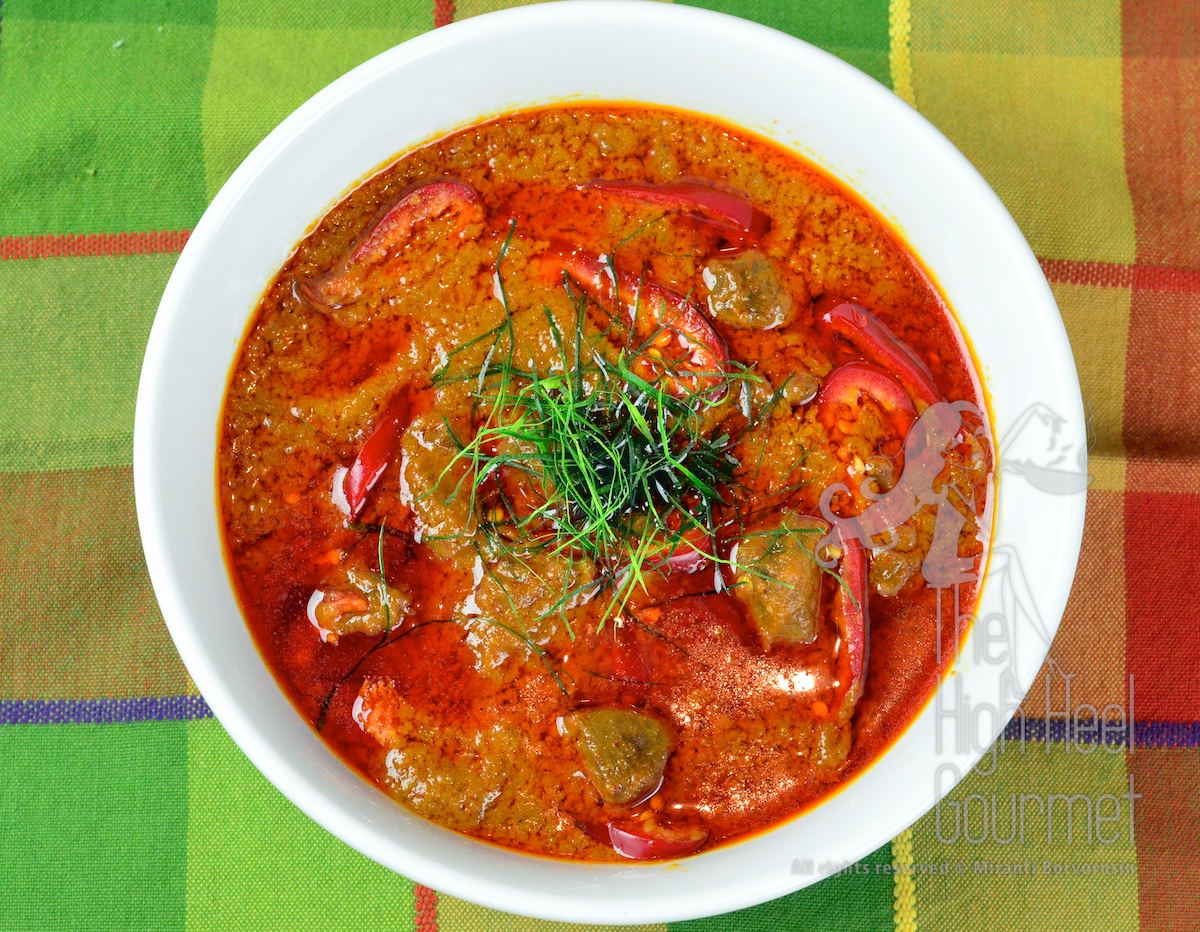
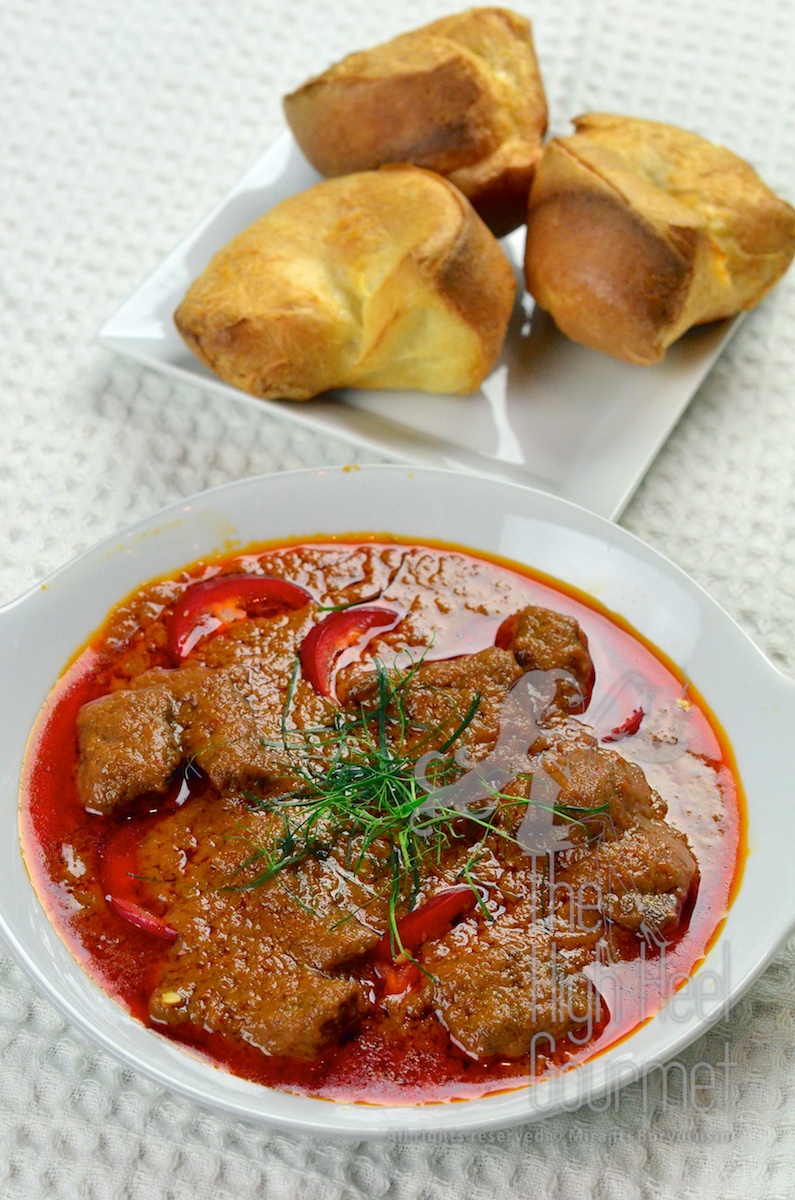
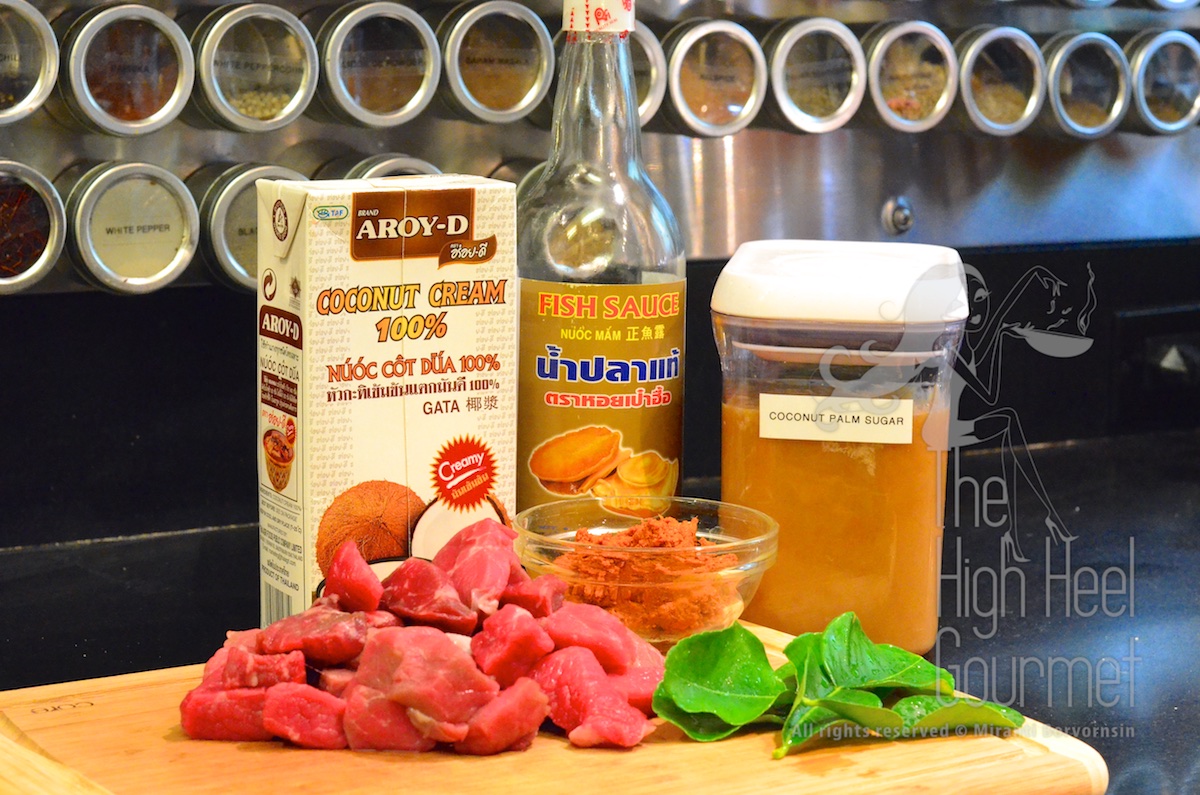
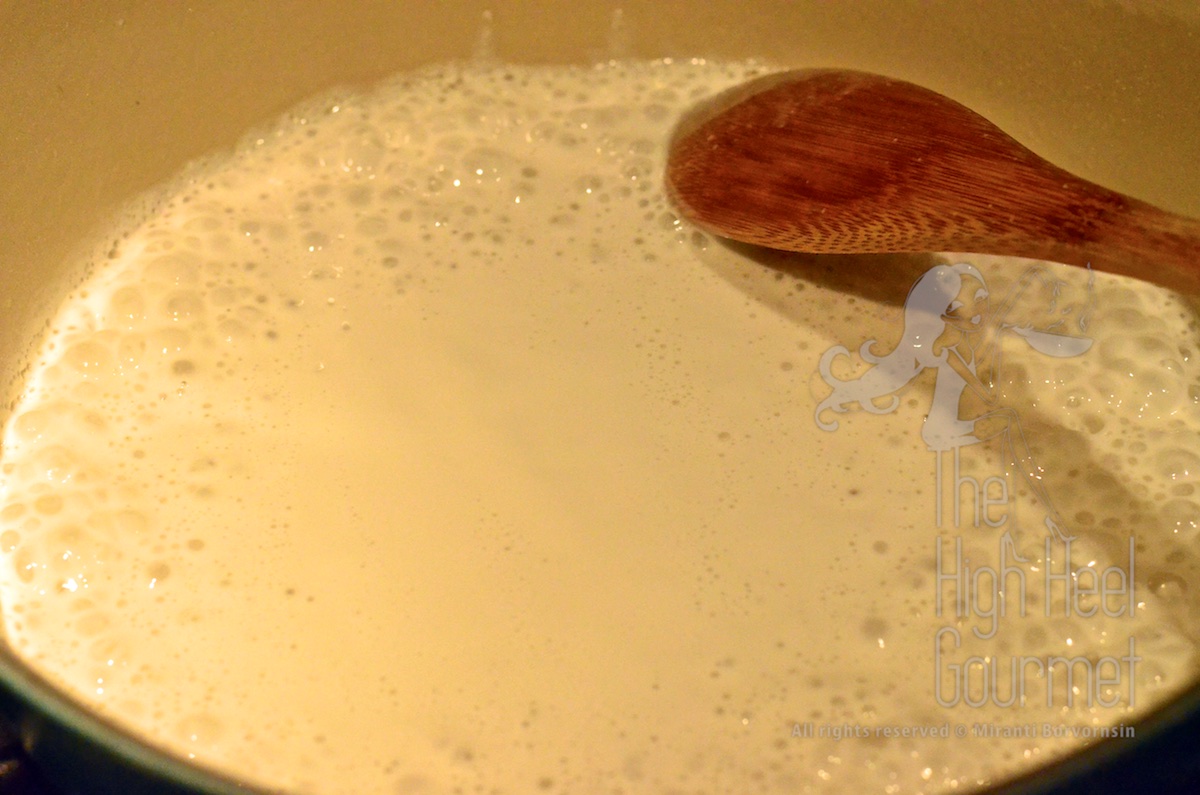
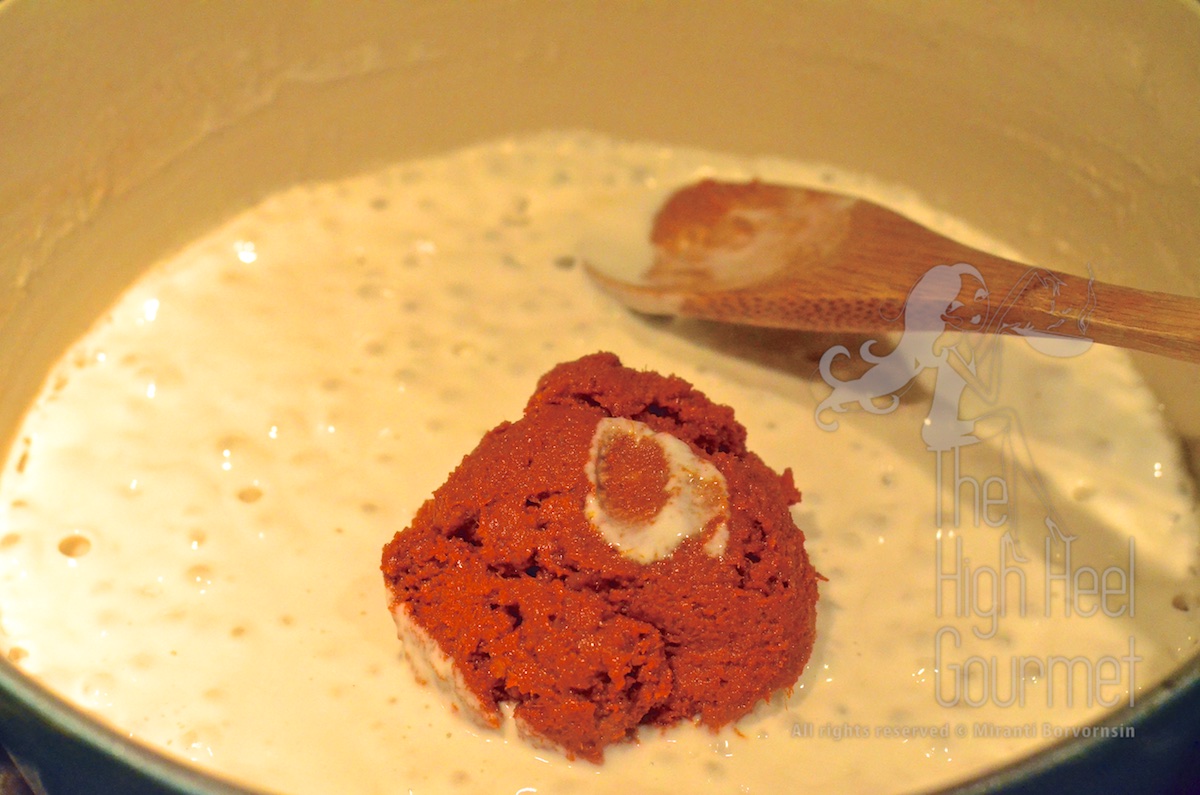
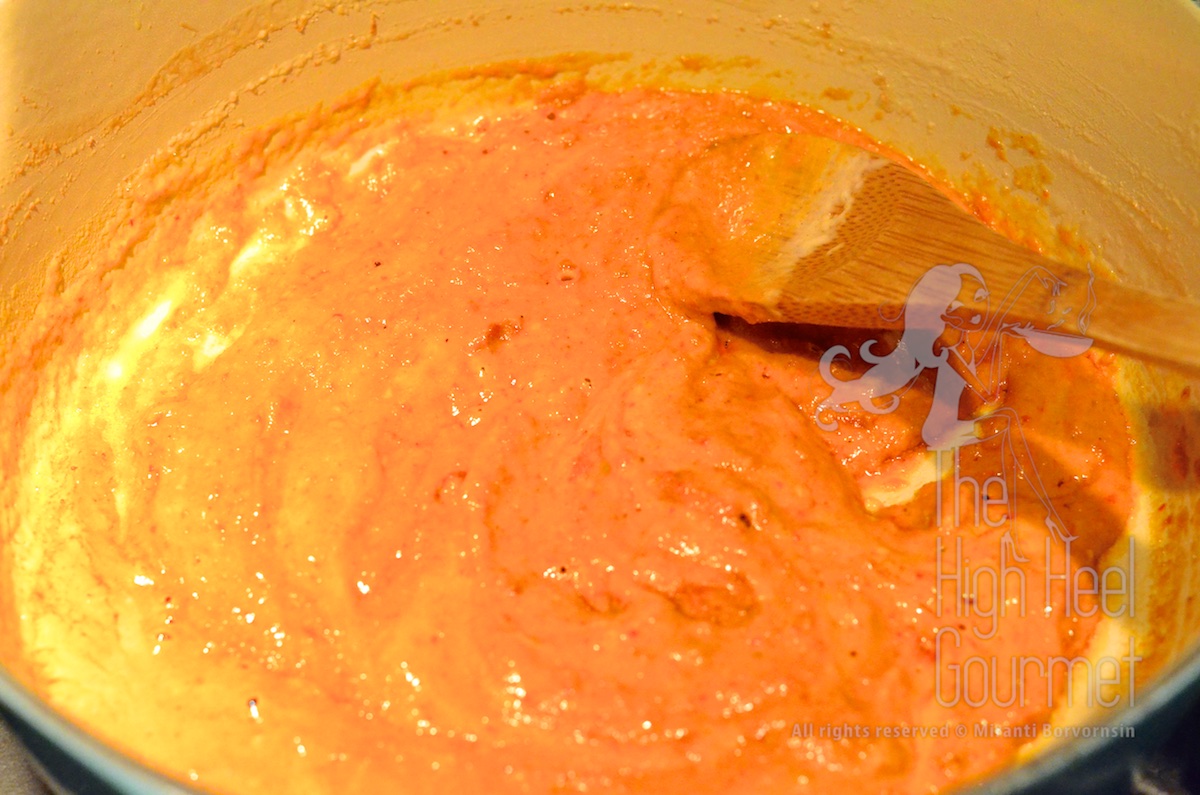
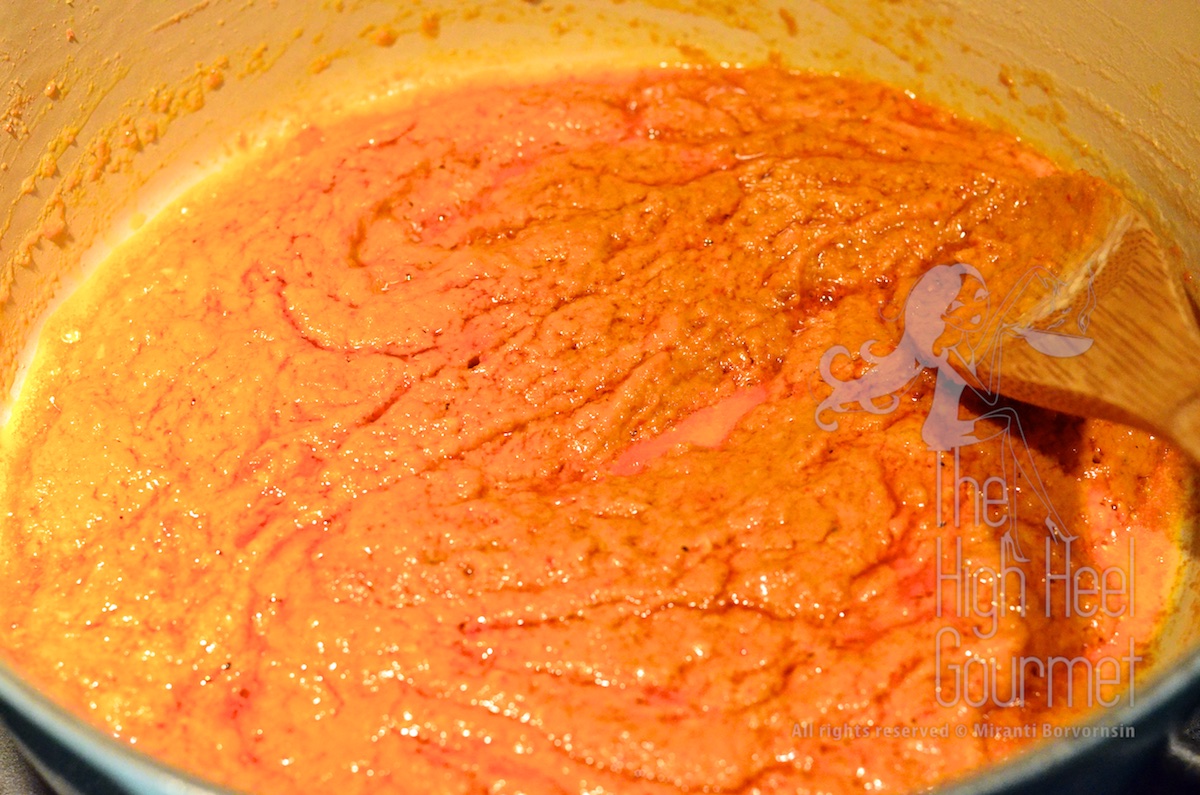
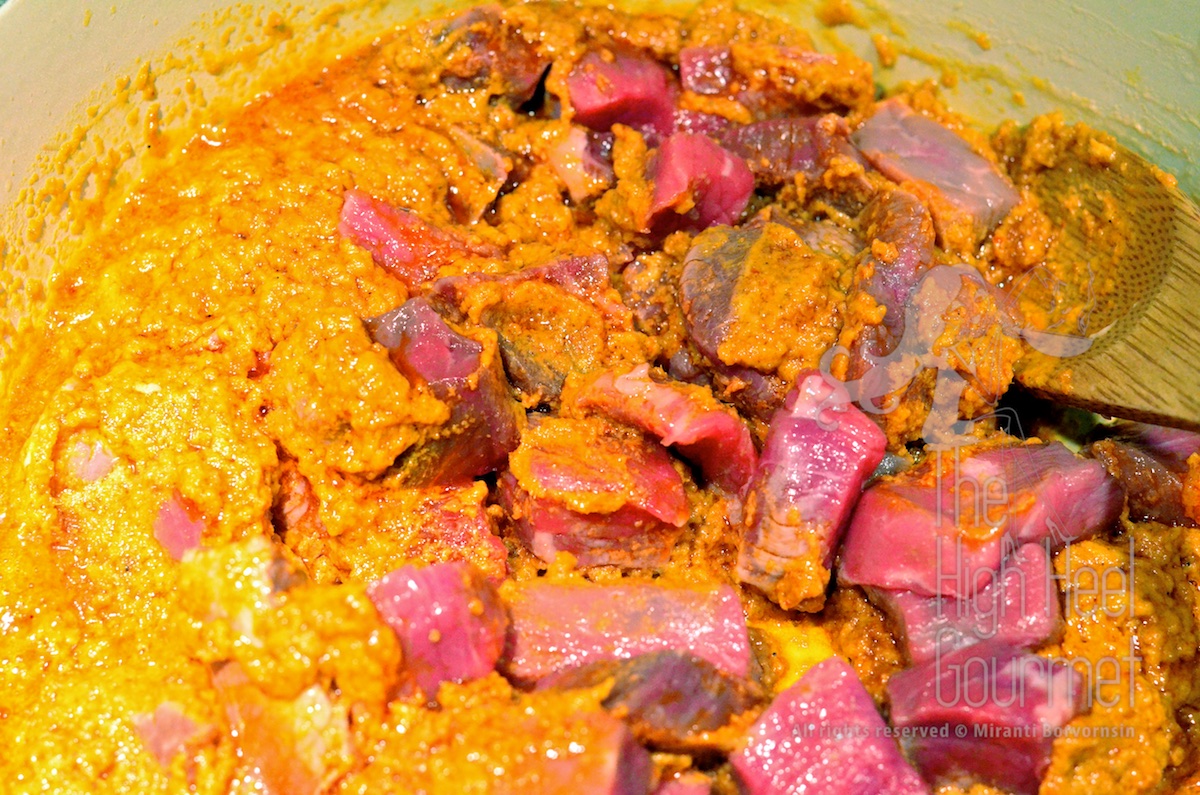
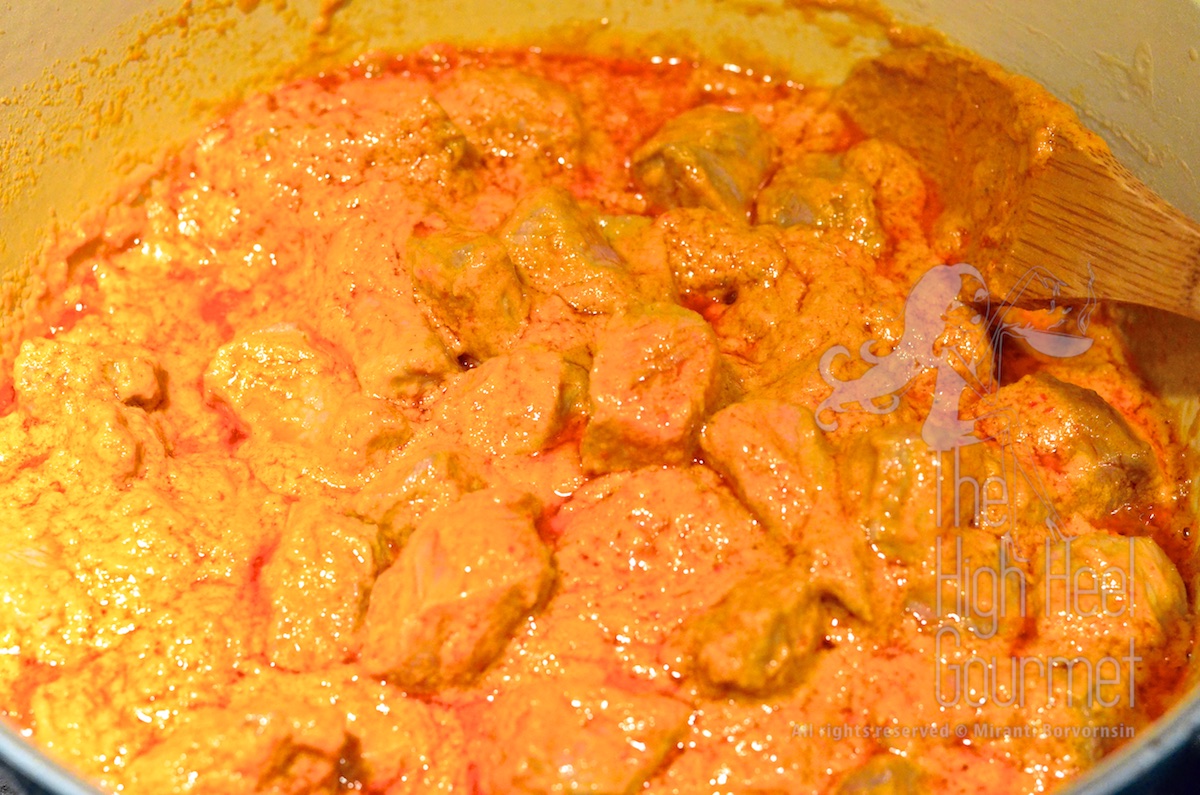
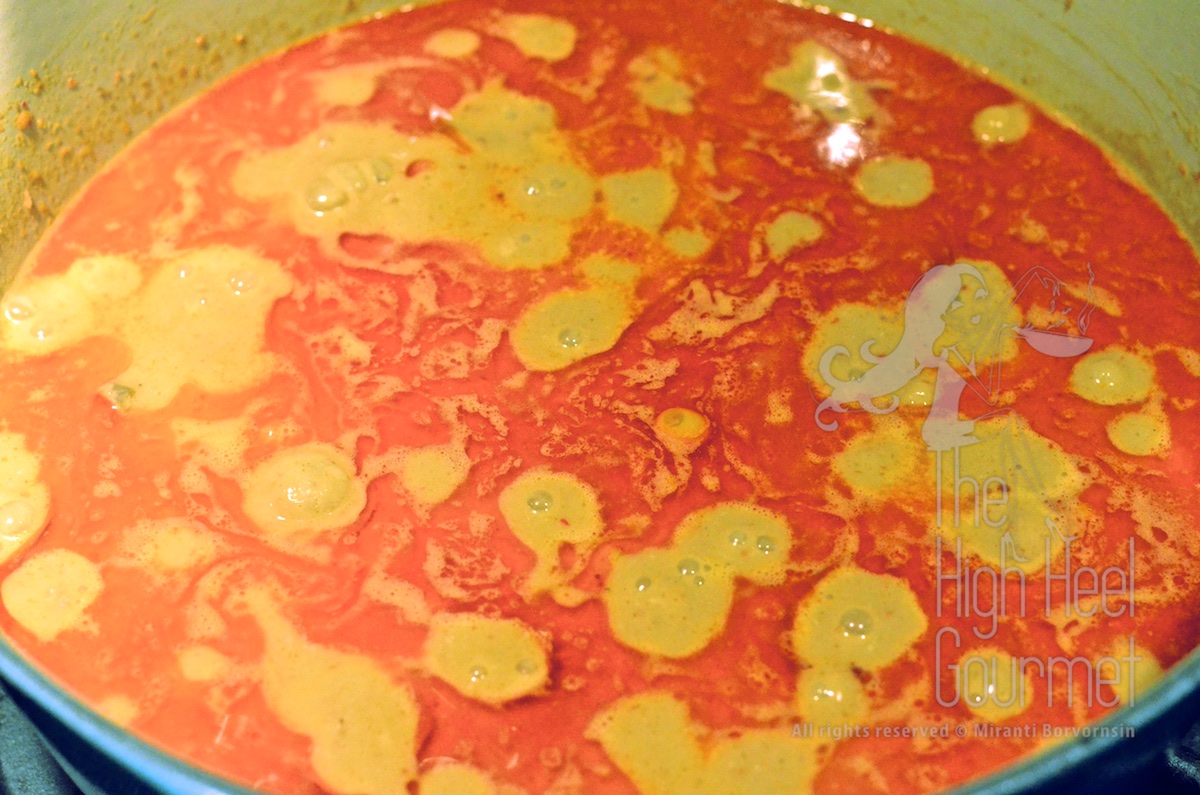
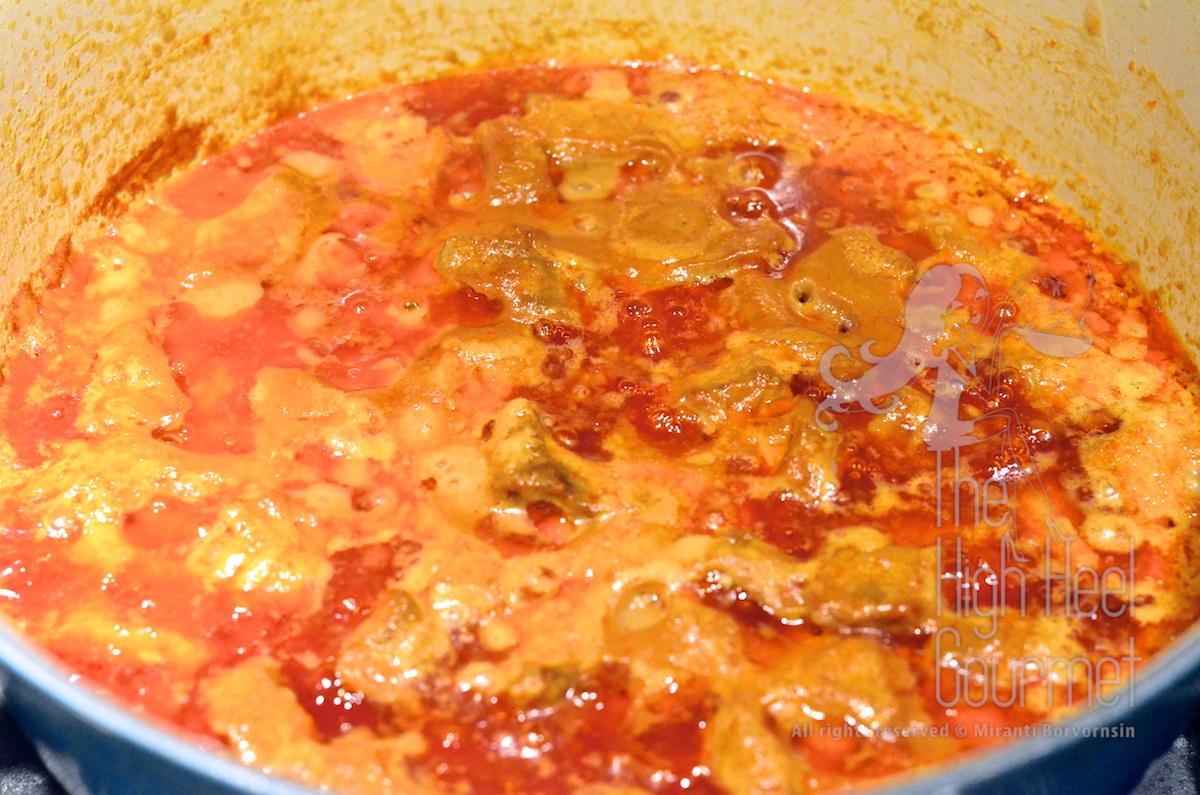
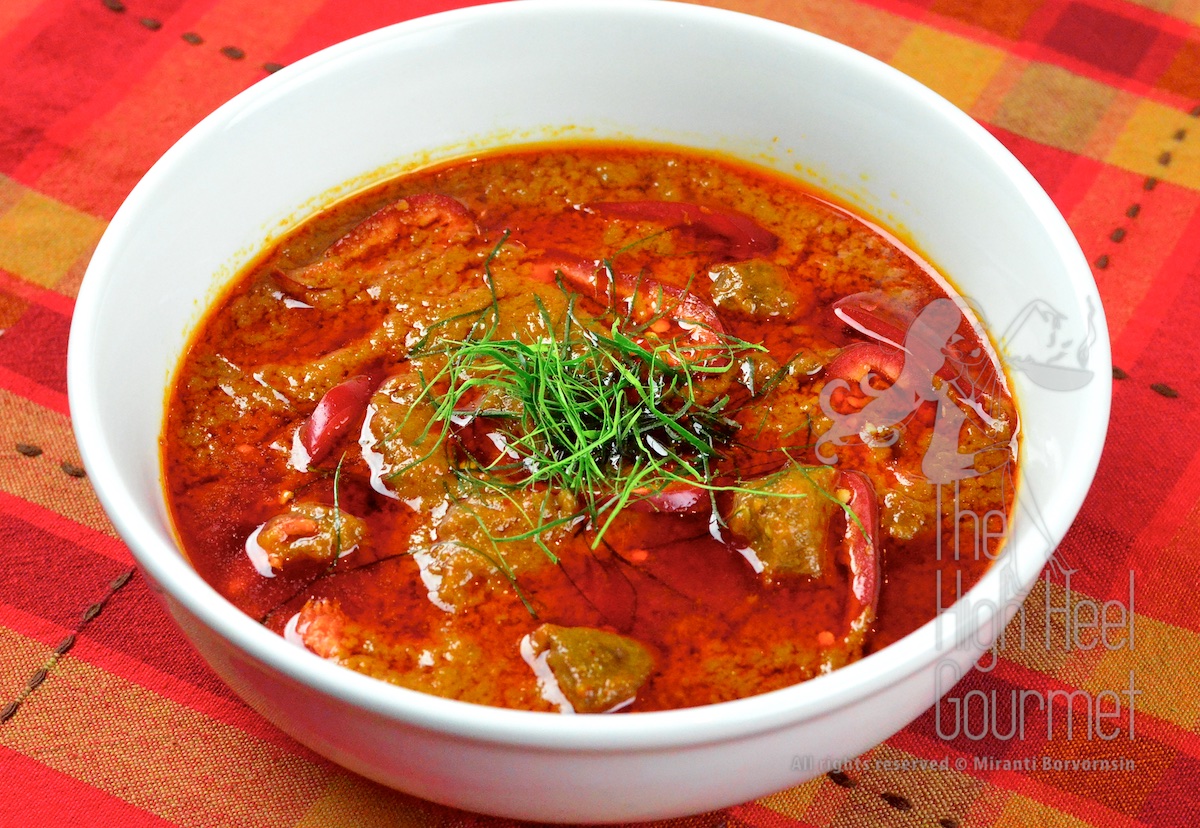
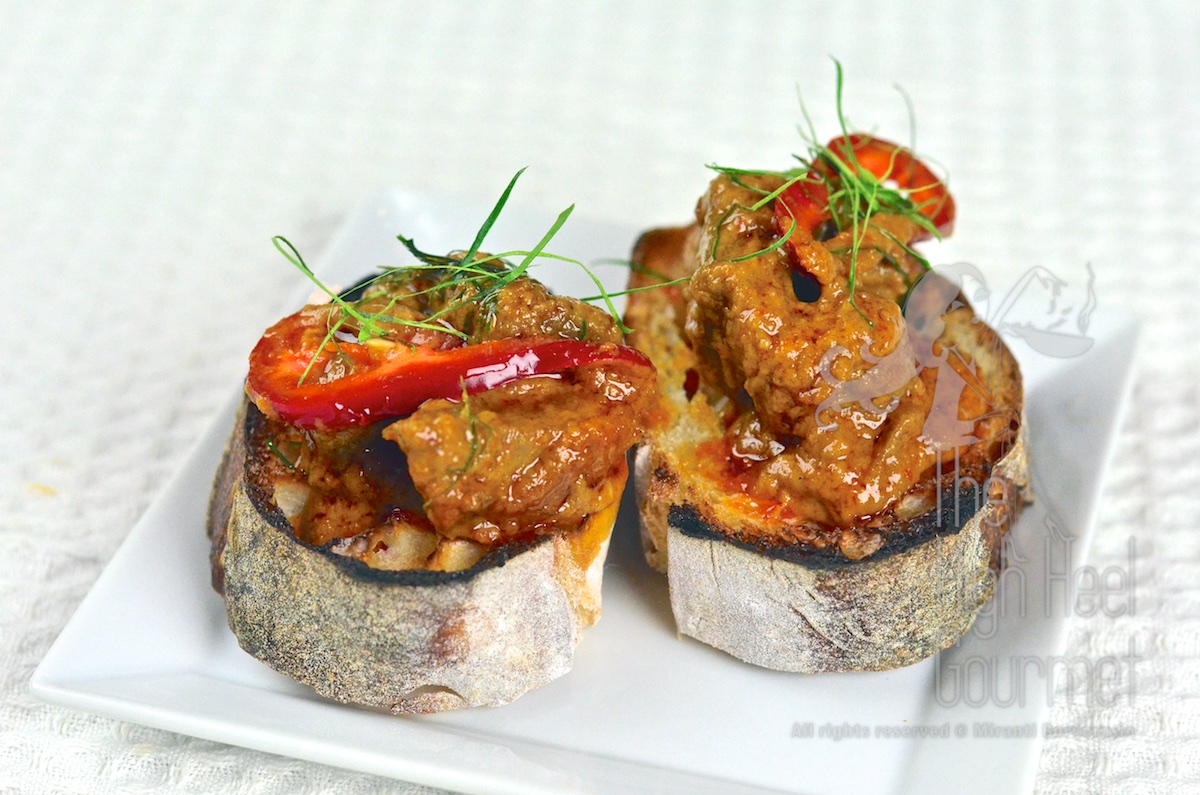
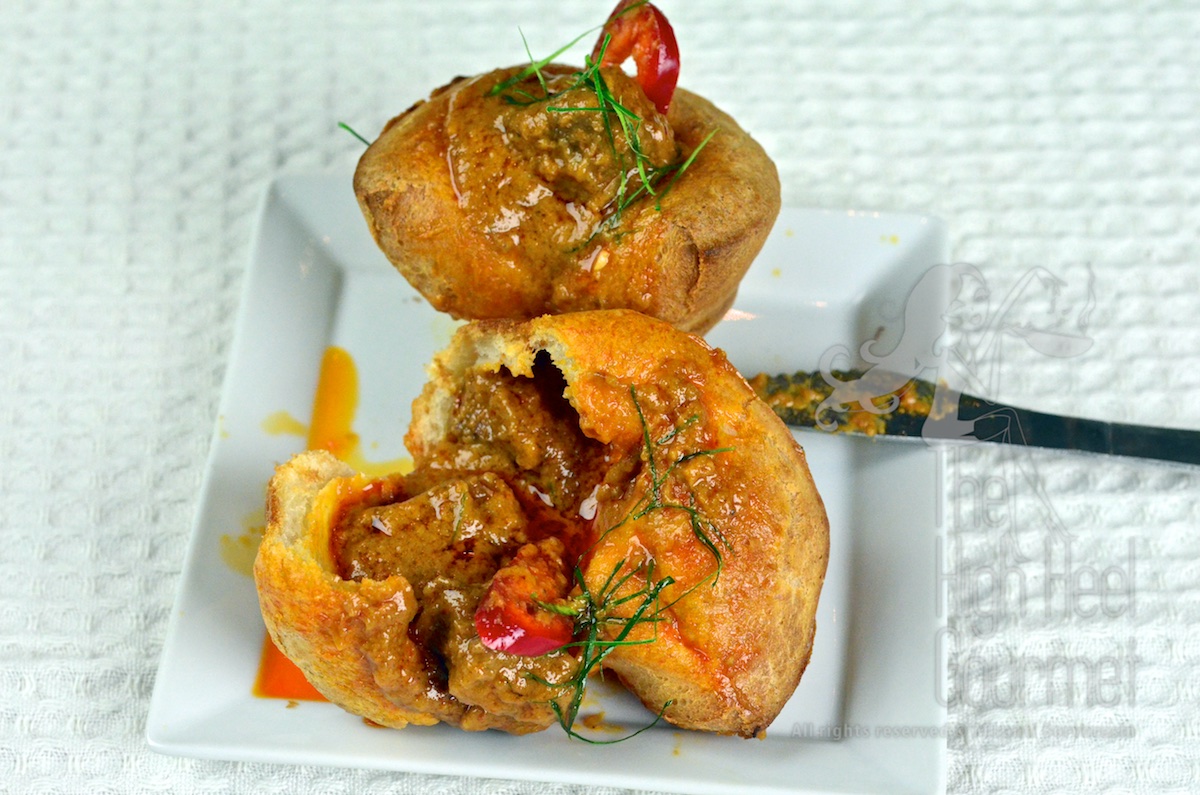
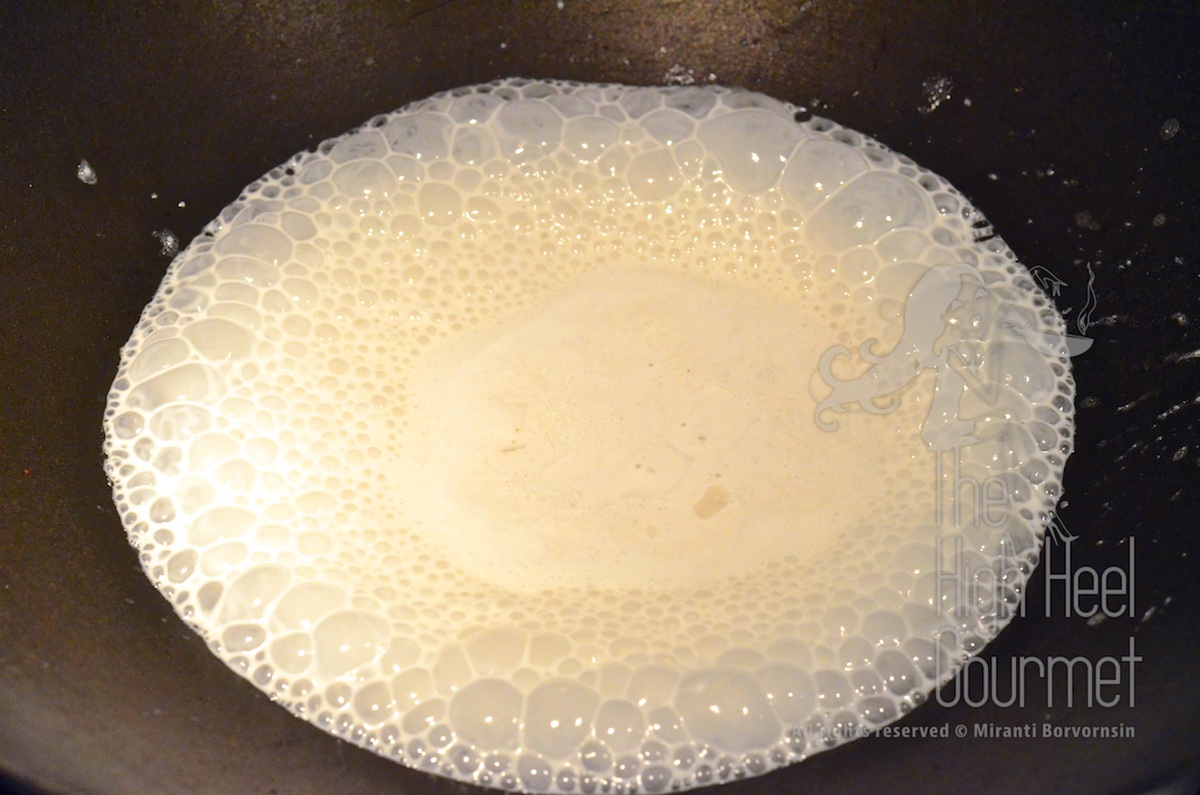
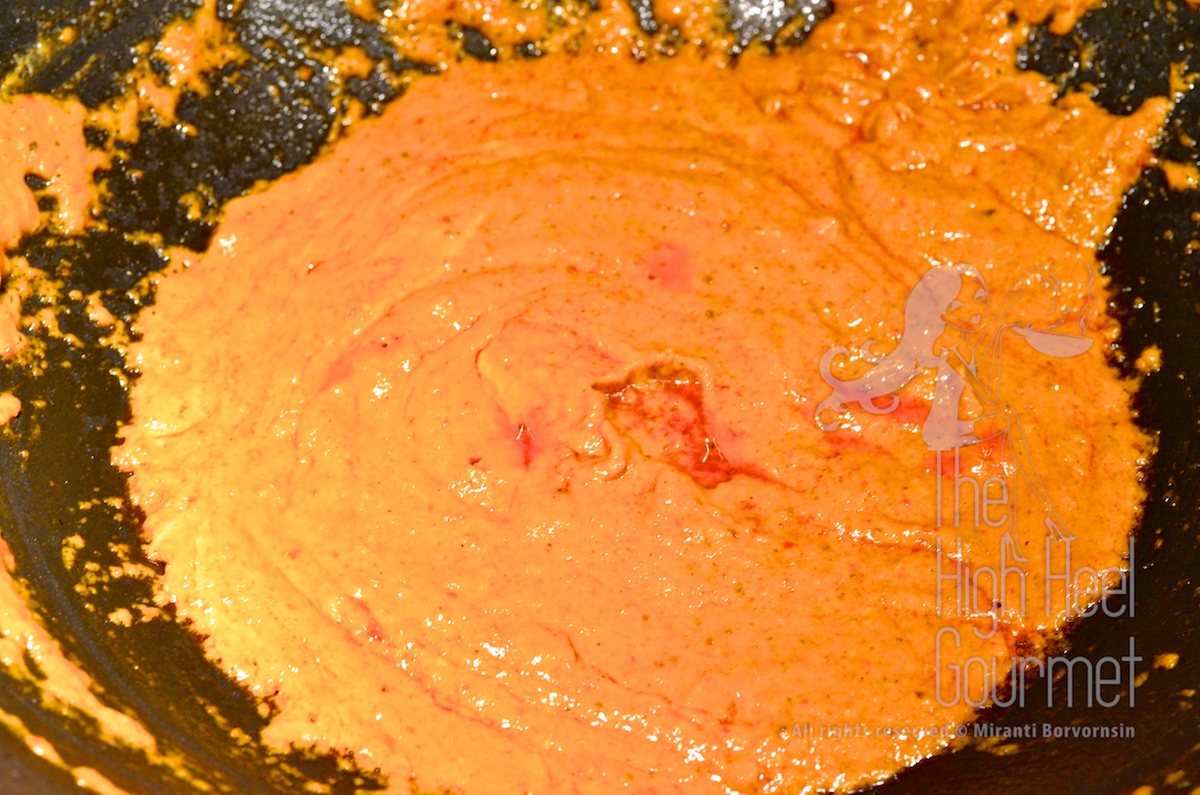
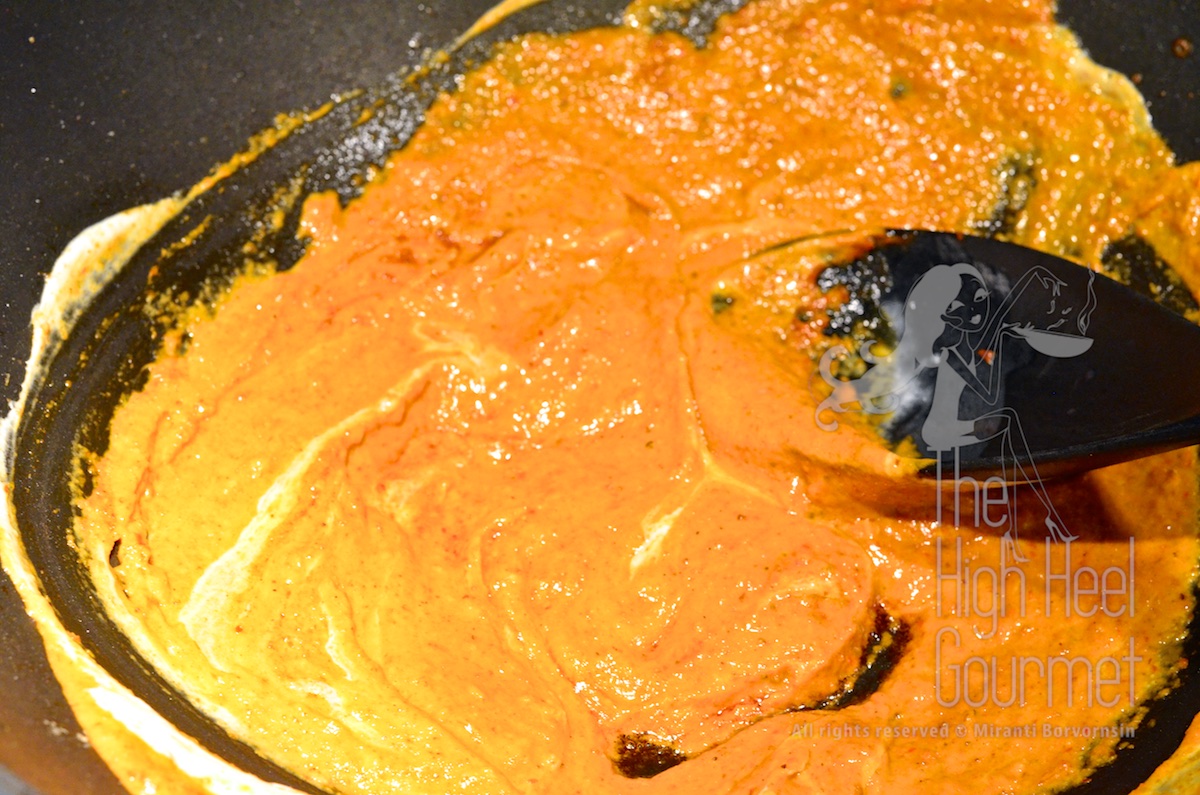
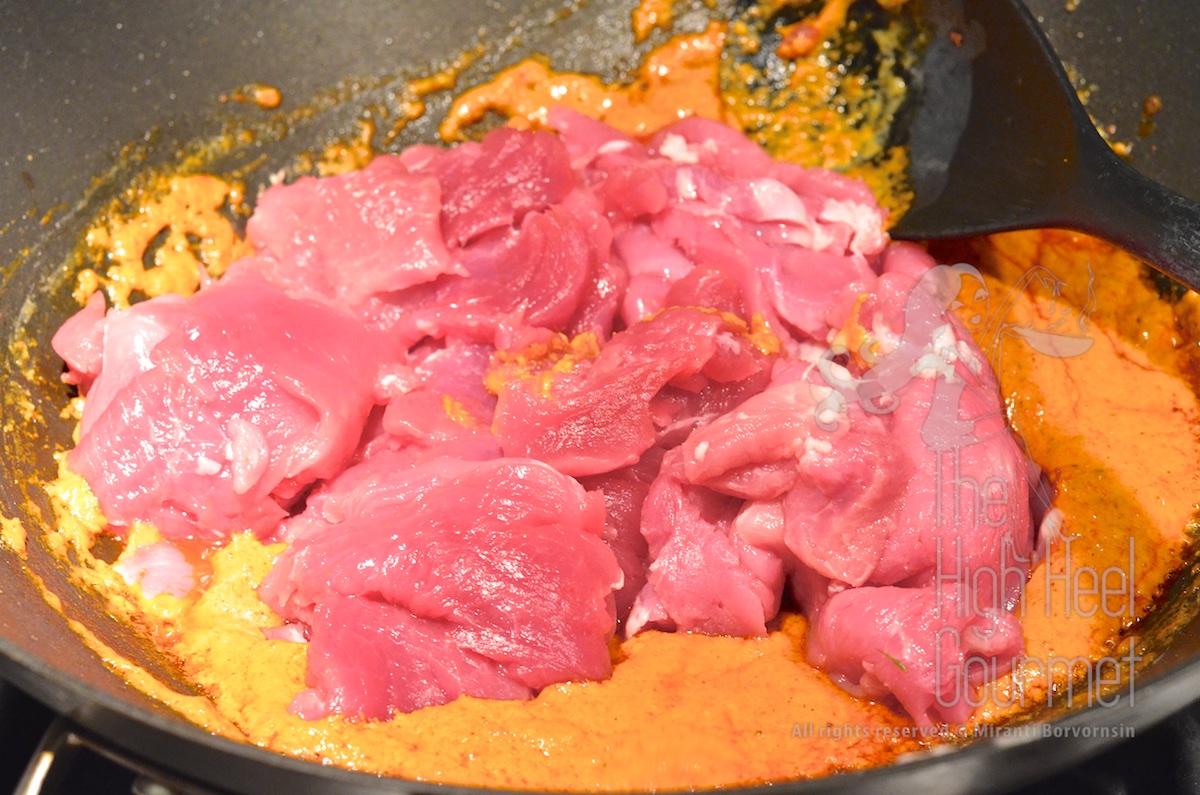
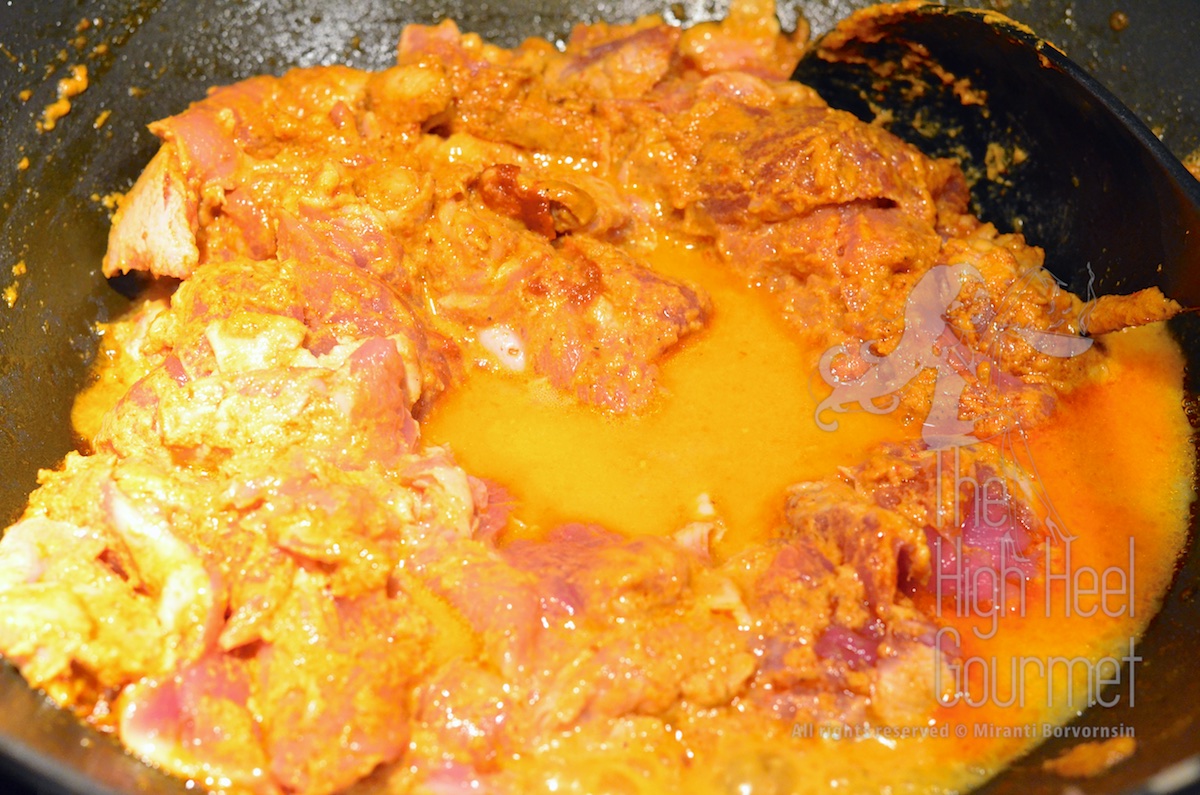
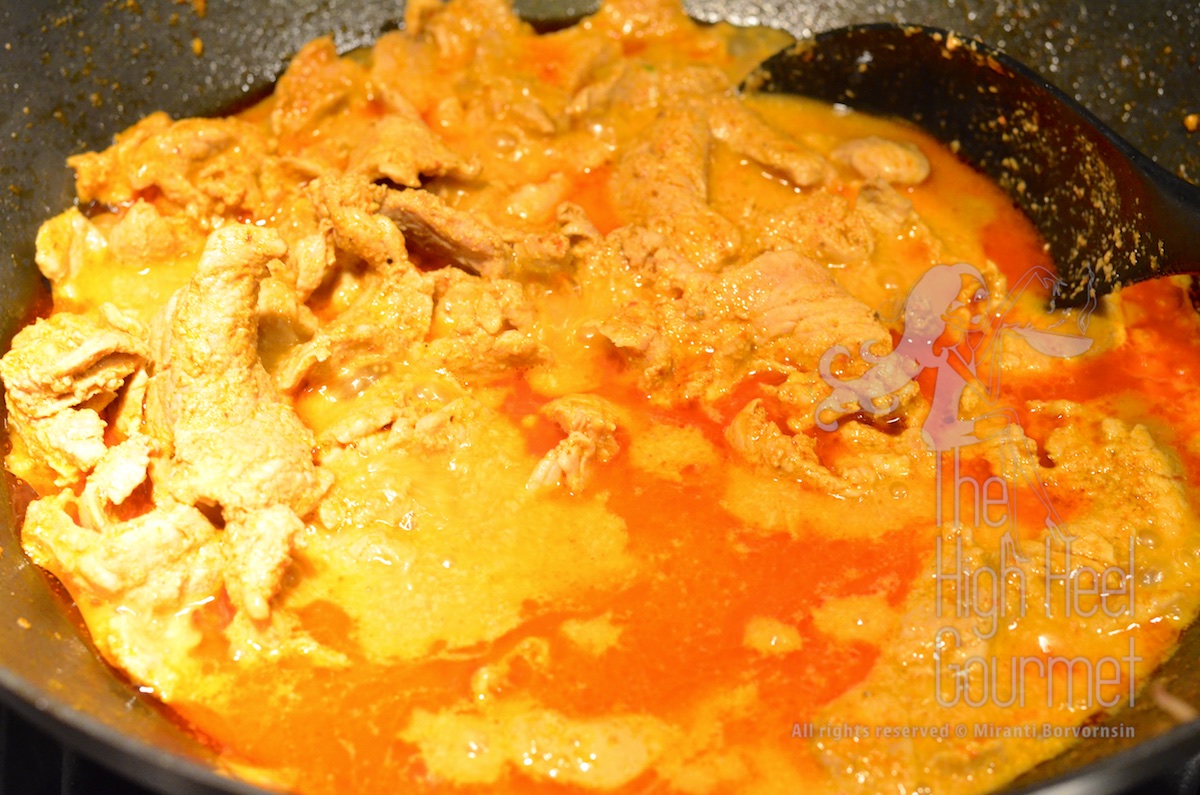
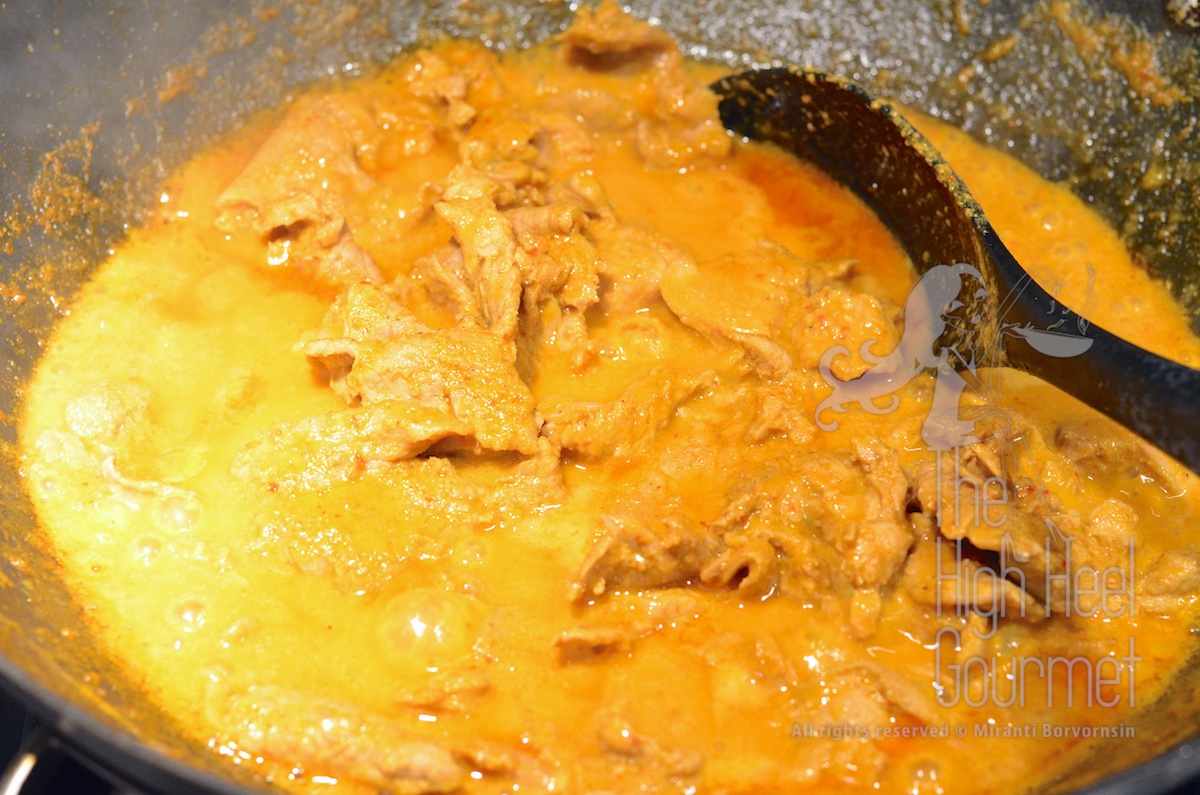
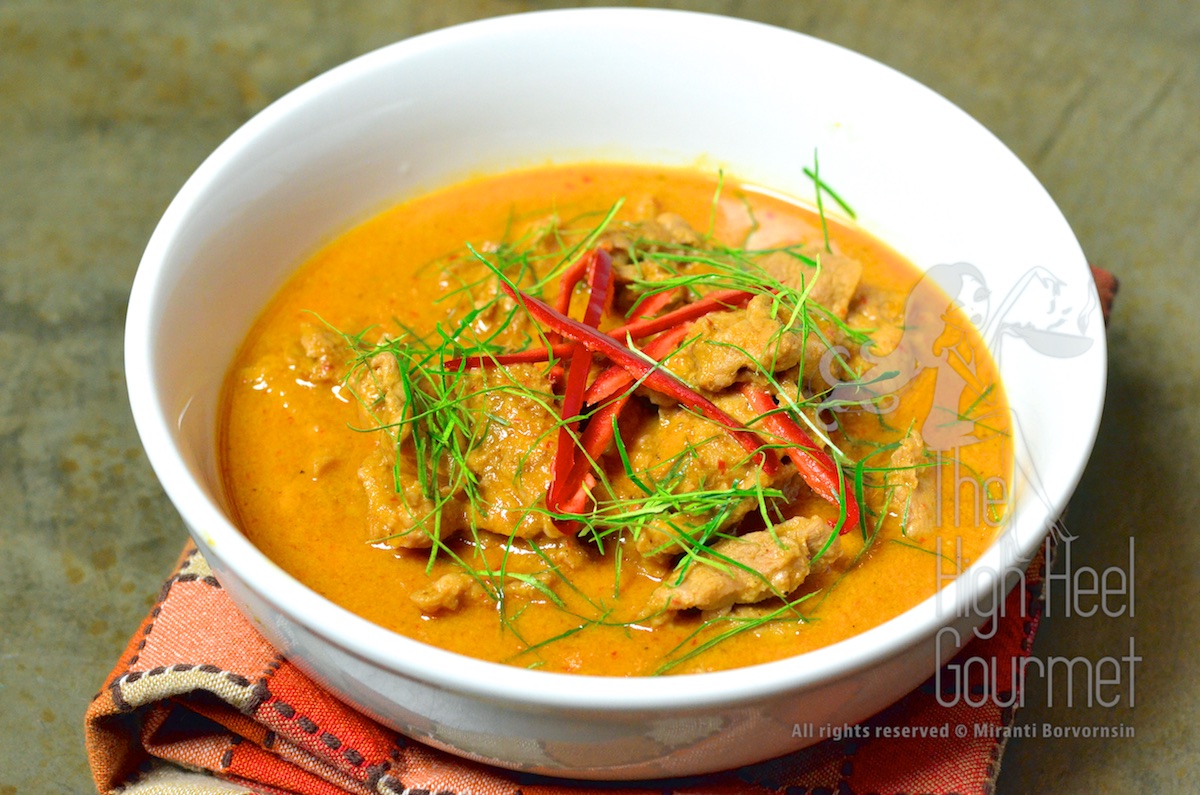
Great delicious feast.Cheers.jalal
Thanks
Your blog is so full of useful info, like for this curry. It gives me hope that we can have good Thai curries at home too, not just go to Chat Thai or Spice I Am (did you try them when you were in Sydney?). Thanks so much!
I tried one Thai restaurant. It’s open air with dessert stand in the front. I have to go back and look for the name because their foods was pretty good. You know I saw the BIGGEST galangal root at the Paddy Market. OMG…I though it was some other kind of roots until I smell it. You guys have the best produces there.
I think I know the Thai restaurant you are talking about! It’s on my walk home from work, and we’ve been there a few times. We are very lucky to have so much good, fresh produce in Australia. 🙂
I had Thai dinner just a couple of days ago, from a restaurant claiming to serve fine Thai cuisine. Not sure I had either, fine or Thai. It was mostly sweet like pineapple juice sweet. Plus a lot of green onions, in the salad and in the curry. I wish you would open a chain of restaurants, Miranti, and serve the Thai food we (read “I”) truly deserve. 🙂
Well I have no restaurant experience but if I can find some chef-de-cuisine I might. It might be a fun project but I really want people to be able to cook Thai foods at home just like the way they do with Italian though. It always taste better that way.
Reblogged this on Deo Optimo Maximo and commented:
Panang Curry is my most favorite dish. Thank you so much for sharing this info.
You’re welcome. Thanks for re-blogging 🙂
It looks fiery hot! Its appearance reminds me of an Indonesian dish called “Rendang”, which was voted somewhere as one of the most delicious things in the world.
I can totally relate to your frustration about that article in Wikipedia. I have found many questionable things they wrote about Chinese and Indonesian cultures. Furthermore, I would not be so surprised that the Malaysian stole another thing from other countries. The “Truly Asia” country had tried to claim many Indonesian things as theirs. The last time they did it, they put the Balinese Pendet Dance in their Tourism campaign. It was quite controversial.
Hari
I LOVE beef Rendang but not a big fan of chicken. You know the Smuck woman at about.com written the recipe for Rendang too. Of course she ignored all the important spices like star anise but she put shrimp paste in it…Yike
I sometime make my cheated Rendang using Kaeng Kua curry paste and added all the spices needed (not in powder form but whole) by frying them before I cook the paste and add the meat. I even used cashew nut butter because it was easier than using candlenut but I think the shrimp paste is the one screaming out loud that I cheated. Even more than the nuts.
Fine cooking magazine website (not my trusted source since they listed a ingredients for PadThai with a cup and a half of chicken stock, basil leaves and most of all when we informed them about the inaccuracy of their recipe. They said recipe isn’t set solid in stone. Great! about 5-6 Thai cooking gurus, who constantly published their Thai recipes on Thai cooking magazines told them they’re wrong. They still don’t care. So we all abandon that magazine, don’t worry) said that Rendang is “Traditional Malaysian dish”.
Hmmm…
People in my hometown do not put shrimp paste in our rendang. 😀 I don’t think the Padang people use shrimp paste either.
Padang Rendang, often called as the “original” rendang, is way spicier than Peranakan or Javanese Rendang. It taste rather bittersweet and very creamy! 😀
Rendang is Traditional Malaysian Dish? I’m rolling on the floor right now hahahahaha
Malay people is somehow related to Minang & Padang people but they are quite different. It would make more sense if they said that “Pindang” is a Malaysian dish (because it is a Melayu dish. Melayu = Malay)
The original recipe I’ve got from my Indonesian friend contain no shrimp paste either…and it was delicious. She didn’t make paste but cracked lemongrass, galangal, garlic, shallots and turmeric before she add them in the pot. She purée the soaked dried red chili though and fried all the full pieces spice. She’s from Jakarta so, I’m not sure if her recipe is original Padang.
Yeah, I think Fine Cooking magazine isn’t doing a through research about the articles they published. They made the most mistake in Asian recipes and origins…ridiculous. I don’t even know how can they maintain their subscribers. Most Asian subscribers are dropping their subscriptions in the last 2-3 years. (I encouraged all my Asian friends to do so…heehee)
OMG! Miranti, I had no idea that you got that side at all! I thought that you were all angel! L-O-L!
Ay, who am I to say that line? Ha ha ha ha ha
I am the one whom they call as lil’ Lucy in college! (Lucy = short of lucifer, they thought I had too many creativity for a human being. “He must be partially demon!”) 😀
This looks amazing! Can’t wait to try the recipe out.
Reblogged this on Tiffany Bleu and commented:
I’m a huge fan of curry. I’ve haven’t taken the plunge to make it on my own yet, but this post makes it seem so easy. I’m literally running out to the store now to grab the ingredients!
I think Panang is one of the easiest curry and not so complicate ingredients especially if you do the easy (cheated) recipe. My friend’s kid can do it in an electric wok at her dorm!
Thanks for re-blogging 🙂
WOW! My mouth is watering again! I think that I should really try to make curry on m own, someday!
Cheers,
Charlie
Oh man that looks good!!
Reblogged this on The ObamaCrat™.
You can almost SEE all the flavor in those dishes! They look amazing!
Loved the culinary history lesson, Miranti. Thanks for the differentiation between Panang and Penang – there are too many misconceptions floating around the internet (including Wikipedia).
Looks Amazing !!
It taste even better than its look 😉
Mouth-watering series, thanks!
Thanks you for visiting 🙂
I enjoyed learning about the history and origin of the dish and can’t wait to try the recipe soon!!
As much as I am with your online store. I just bought the high heel cookie cutter in both sizes. I LOVE all the paper straws too.
Aw!! Thanks so much Miranti. So sweet of you and much appreciated. xx
The colour of this panang curry is so rich! I didn’t get a chance to taste this in Bangkok but I will remember to try this curry next time i go to a Thai restaurant 😀
Sam, It’s so delicious. I don’t know if the restaurant would put the ground peanuts in the curry though. I’ve found that they normally don’t (even in Thailand) and that diminish your experience. Can you ask your friend to make the dish for you?
you are amazing !! im trying this asap !
🙂 Cool…Thanks
Miranti, if you use UHT Coconut cream in the box (as pictured) you do not need to do the step of separating the cream – that just applies to the canned coconut milk – chy my kah? May I mention that UHT is a relatively new process of food preservation, in which the coconut milk is heated up to super high temperatures very briefly to kill all bacteria etc. I could not find any information on what this high heat treatment does to coconut milk in English but I did post a comment on the Weston Price UHT dairy milk page, about UHT processing (http://www.westonaprice.org/modern-foods/ultra-pasteurized-milk); I am still searching for any lab/nutritional studies on UHT processing of coconut milk, if anyone can direct me. Thanks!
Chai laew ka…Yes, if you are using the same one I use, you do not need to separate it. This brand even put the word “Coconut Cream” on the box and it’s quite thick even though there is some water in the box but consider the consistency, this is the closest to the hand squeeze coconut milk.
From what I remember the temperature of UHT is really high, way over boiling point of water 135 C if I remember it correctly and it slightly different between each liquid. It’s actually depend on the type of bacteria spore that contained in that liquid and what’s the temperature to kill that spore. For more detail, I can connect you to some of my alumni friends who major in Food Science at Chulalongkorn and might still be teaching there naka. My major was Photographic Science ka sorry. My knowledge is quite limited in a deeper and specific subjects.
Yes please send my contact if you can, thanks!!
This looks wonderful! I love all the spices. It was very interesting to read the history part of it. You have so much knowledge about your dishes. I agree with the commenter above that said you should have a restaurant. Is that something you ever considered?
Thank for your kind words. 🙂 I’m pure bred Thai, you know. We eat these foods even before we can read or write. So, the histories or how to cook the dish is already embedded in as a part of growing up. As for opening the restaurant, I never cook at a restaurant before and don’t even have knowledge about how to stock and re-stocking the supplies and stacking the orders, all other important experience of the restaurant owner. So, I’m quite gun shy about that. If I have a good chef-de-cuisine I might consider it.
You are such an amazing teacher! Findign ingredients is hard for me here in New Hampshire. Any online markets you can recommend?
http://www.templeofthai.com
http://www.friedas.com (I love their lemongrass)
You can try to search in amazon.com and compare the price. A lot of my friend like temple of thai the best with their customer service and products. I used to recommend importfood.com but not a very good experience with customer service a few time so I stop. They might already fix their problem but I’m not sure.
Looks awesome 🙂 I love galangal, and I’ve been wondering where it is in the Indian recipes! LOL I guess I can stop wondering. I sometimes will boil a dried root slice and let it soak in the fridge for days until I’m ready to flavor a soup with it, but of course you’re giving me new ideas. The smell is ethereal, almost floral, but kinda spicy too. Heh, do I sound like a perfume commercial or what?
Have you try Tom Kha (http://www.highheelgourmet.com/2012/02/16/tomkha-lobster/) ? It’s very strong galangal flavor and they flavor Tom Yum (http://www.highheelgourmet.com/2013/04/25/tom-yum-goong/) quite nicely too. I totally understand your perfume commercial 🙂 I LOVE the smell of it so much. Sometime I made simple soup using the young galangal and garlic to make broth then add fried chicken wings in the soup and simmer until the meat fall of the bones and garnish with cilantro. That’s it.
As always: beautiful images, beautiful food, precise instructions and step-by-step how-to photos. Thanks.
Yummm!! Amazing!! Looks so good – and I love the detailed description. I am totally going to try this. I am actually half Thai (and born in Bangkok too!), so I make Thai curries, but mine are super westernized (and so are my mum’s since it was hard to find ingredients in Switzerland where I grew up, so we learned to adapt ;-). Anyways, I need to learn from you! Thanks so much for posting and happy to have come across your blog 😉 Greetings from Miami.
Yike…I’m so sorry, I missed your comment for this long 🙁
I’m glad, you enjoy my blog and I hope it’s useful to you.
If you want to know any Thai recipe, you can request it too. As you already seen that I’m so not good with answering comments, I would say request for recipe on my Facebook page will be a better and faster way to respond.
Happy New Year and Happy Chinese New Year to you and your mom 🙂
Thank you so much!! i will definitely let you know!! 😉 I came across some interesting looking dishes during my trip to Thailand and I would love how to make them. I will send you a picture via fb 😉
Reblogged this on This Got My Attention and commented:
My favorite Thai dish!
Reblogged this on raiseatoast and commented:
Simply appetizing!
What panang curry do you use for tofu?
I’m not sure if I understand your question. You can make Panang curry with tofu using Panang curry paste. Is that answer your question?
I am learning so much with this blog… thanks thanks thanks
Just wondering, can the roasted peanuts be substituted by almonds or cashew nuts? Or is it non negotiable?
Go for it. I think cashew nuts would be nice, almond has much less flavor than the other two but it would also make the curry thicker too. My grandmother always use roasted, shelled mung beans instead of the roasted peanuts too and that has way less flavor than the ground almond. It’s something she always had in her kitchen.
I might even try that myself sometime.
Love all the detail you’ve put into this. A great blog. 🙂
Last time I was in Thailand, I found a lot of people in the Khao Lak and Khao Sok areas omitted the coconut cream in favour of a little coconut oil. The dishes came out a bit more like stir fry with lots more kaffir leaves running through it than I’d had before.
One of my favourites!
I think you probably had a different dish. My guest is it is Kua Kling or Moo Pad Kreung, pork stir fried with peanuts. I’m just guessing from the area location. If you have picture show that to me.
No photo unfortunately but I did ask the cooks (in Thai) both times I came across it. Once it was done with prawns (they offered with or without coconut milk), and the second time with fish (although that’s all they had on the lake). Both dishes came out quite a deep brown from the paste. Does sound like your Kua Kling suggestion, although I could make out the dry spices in the taste.
If it is Kua Kling I am debating about putting the recipe up, or not because it’s not well known among foreigner yet but I might. It’s one of my favorite but I can’t “buy” it anywhere because it’s always too spicy for me!
Nick when I make Kua Kling, I will take a picture and tag you to look at it to see if it is the one. 🙂
My goal this year was to make a “good” Curry since my family loves Thai food. I tried all the pastes in the stores and was always dissappointed. With your recipe and instruction – the Panang was awesome!! If I want to make straight red curry follow a similar recipe by adding your red curry paste to the coconut cream like for the Panang – ( no other additions ?)
THANKS!!
Regular red curry I assume that it is Kaeng Ped, or Kaeng Kua. This is the recipe of red curry with roast duck http://www.highheelgourmet.com/2012/11/22/roast-duck-curry/
It is so annoying when this dish is referred to as Panang. This is how it is always written in menues for western people. A Panang curry is a curry made from a wall. It has NO other meaning! I have been in countless Thai resteraunts and asked why they describe it in their menues as Panang. They have no answer as they know it is rubbish. It is written like that because western people are used to seeing this incorrect description and recognise it. What stupidity, to continue with the mistake rather than to correct it. It is Paaeng, or Paneng.
The other thing, done for westerners, in Thai resteraunts located in western countries, is playing Isaan music whilst presenting a menu to customers devoid of any typical Isaan food. OK the thinking is probably that Isaan food is not to the taste of many ( including myself) which is very understandable, but to not have any well known recognise able Thai music, at all, only Isaan music, with central Thai food. What makes it worse, is that in western countries, no specific Leek a Teet ( licence ) is needed for the establishment to legally play music originating from anywhere in Thailand. So glad I,m in Thailand, fantastic Thai food for 35 Baht, not twenty American dollars, perhaps if they introduced some Lot Pooungs to Manchester, and the bars had friendly girls who let you bring the food inside to eat, I might be tempted back to western countries ( if I can avoid wall/floor/window red curry) but I recon that is a very long time off.
This looks so delicious !
I’ve cooked an admittedly different version of panang curry, which was very close and the added peanut butter seemed to throw the flavor way off. Do you think that peanut butter might be a problem or that there are particular brands of peanut butter that are preferable to others?
I’m making the slow method of panang beef tonight using either hangar or skirt steak. My wife loves panang beef!
BTW, I love your blog!
Thank you for your awesome article! I just came back from NaiYaRa restaurant, the chef is supposed to be great, the concept is Asian fusion,
So the place was packed the waiter was in a rush I overlooked the menu and saw Panang Curry as one of the dishes. And so I order. It took about 40 minutes to get the food and I realized I had order Panang Curry with Soft shell crap… Agghhhhh I can’t have that. I was expecting chicken panang. The waiter comes to me and said “oh that’s weird you assume it was chicken because soft shell crab panang curry is traditional in thailand” So I’m glad to read some history of the cross-legg chicken. Knowledge is power. So thank you! Now I can sleep!
Really they said THAT! That’s really bad. We normally don’t make seafood in Panang curry. We will do ChooChee curry with seafood and Panang with land animals meat. That’s the traditional.
LOVE Panang curry! So, essentially Panang paste is different from the Red curry paste because it has roasted peanuts and some fresh shallots pounded in as well? So if I make the Red curry paste and pound in the roasted peanuts and shallots I can use the paste make the Panang curry exactly how I make the Red curry (cooking the paste in coconut cream and adding the vegetables, coconut milk and seasoning)? Is there anything I need to consider to make the curry more different than a red curry? I did read that you traditionally do not use basil with Panang like you do in red curry. Also the peanuts that are pounded in the paste are to be completely smooth right? No bits at all and the paste needs to be super smooth just like all thai curry pastes?
I can’t thank you enough for your amazing blog! xx
Yes, you figure that out, good 😊
The cooking is just slightly different with the amount of water added. You should try to keep the Panang very very thick, gravy like consistency but Kaeng Phed, you should make it soupy like a thin chowder. Panang use chiffonade Kaffier lime leave and red curry use a torn whole leave and basil in the soup.
Awesome! Understood. It’s so satisfying to make a dish and know that I am doing it right and not butchering it completely. Thanks xx
We used to live in the Chicago suburbs and went weekly to a Thai place near our home. We moved over 10 years ago and when we travel through Chicago, try to find a way to get back for Thai. Paba Li’s Panang was to die for and we haven’t had any as good before we had hers or since… until… I made your red curry paste and the Panang Curry last Friday night. I tasted it and knew, then my husband tasted it and said, “That’s it!” Spectacular! Thank you, Thank you! I can’t wait to try your basil beef noodle recipe. Ingredient list looks like it could be the same as Paba Li’s, too. Love your explanations of the curries and your detailed instructions. It was a lot of work, but I’m sure now that I’ve been through the process, it will be easier next time. Thanks again!
It sure to be much easier and if you make it often enough, you can make the curry paste and keep it for the next time.